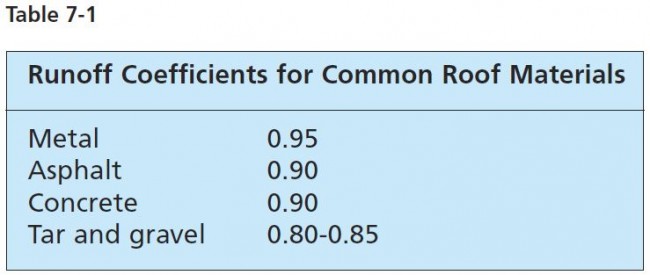The PermaDesign Weblog, with Nate Downey and Melissa McDonald!
Roof-Reliant Landscaping™ Step 15B: Water Collection - Runoff Coefficients
When calculating the amount of runoff that can be harvested from a roof, it is common to include a runoff coefficient. This coefficient accounts for the fact that some roof surfaces are more efficient than others at collecting rainwater. For example, a pitched metal roof is typically the most efficient type of roof for collecting water, delivering 95% of the water that falls on it (except for some heavy snowfalls). Conversely, a flat tar-and-gravel roof is typically the least efficient roof type, delivering 80-85% of the water that falls on it. Table 7-1 lists the runoff coefficients for common roof materials.
Please note that the figures in Table 7-1 are estimates. In a very light rain event, the runoff coefficient can equal 0.00, since no rainwater will flow through your catchment system into your cistern.
Throughout the text, the common term “flat” is used to describe both flat and seemingly flat, low-sloped roofs.
For water quality issues, contact the New Mexico Environment Department Water Quality Bureau.
In Chapter 3, Sizing Your Cistern, the runoff coefficient was not included in the calculations you made when estimating anticipated rainwater harvests. Instead, you were encouraged to use a generally cautious approach to predicting rooftop rainwater harvests. The decrease in harvested rainwater due to loss from the runoff coefficient was one of the reasons for this. If you would now like to include the runoff coefficient in your rainwater harvesting calculations, you can more accurately predict the net runoff.
01/15/2016 | (0) Comments











Comments